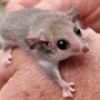Fowlers Bay - Explorations Into Insects!

Alexandra Fowler
An overview of my day with the Terrestrial Invertebrates Team! The day was spent scouting locations and had a few cool finds, and I learnt a lot.
Today I went out with the invertebrates team. The first insect we caught was a Robber Fly. It was really good specimen. I was the one who spotted it. Robber flies pounce on other flying insects and drag them down to the ground, where they eat them.
We continued along the track and found some native bees. The native bees are kept alive until we get back to base camp. Then they are preserved using a very delicate technique. They are Frozen then they are pinned. Freezing them means they are soft when it comes to pinning them allowing them to be put into specific positions. These bees are part of the Family Coletidae
We also caught some Chalcid. Wasps which are native species of wasps. The ones we caught were a very small species of these parasitic wasps. The different types of Chalcid. Wasps will lay their eggs in various places from inside the eggs of other insects to inside the bodies of other insects and arachnids. These tiny species often lay their eggs inside the eggs of other species.
We travelled along a very narrow track that the car only just fit. We were running along the side of a huge sand dune. Sand dunes move over time and when we stopped and climbed the sand dune we came across these strange bushes. They weren't bushes though, they were actually the tops of the trees that had been buried as the sand dune moved. We had easily climbed 3-4 metres high up the side of the dune. It was absolutely fascinating to see the trees still living while buried up to its top branches under sand.
Near where we climbed the sand dunes we found a prefect little corridor with thick folliage and flowering guns next to it. THis was the perfect place for a Malaise trap. The Malaise trap looks a lot like a tent and the set up was pretty similar too. The trap catches insects as they fly down the corridor and when they hit it they fly up the roof of the trap stops them getting out. They fly to the highest point where there is a container full of ethanol that they get stuck in. This preserves them for the scientists to study.
We continued following the tracks and ended up looping back to where we started. There were a few more stops with some insect finds and we investigated a few areas. We were mostly looking for flowering plants and places with dead wood. It Was a great day!

